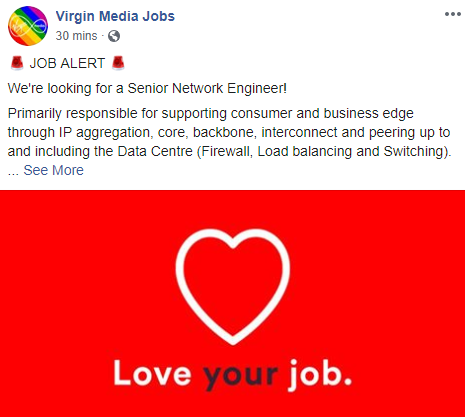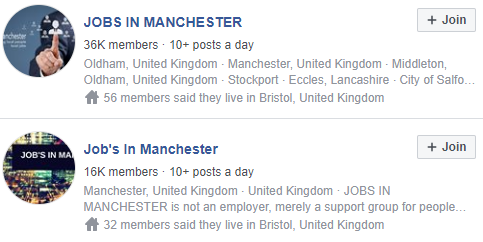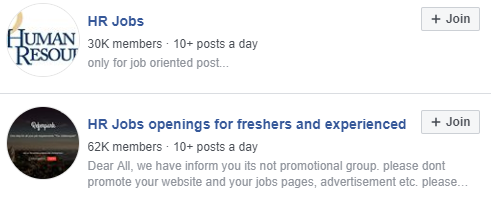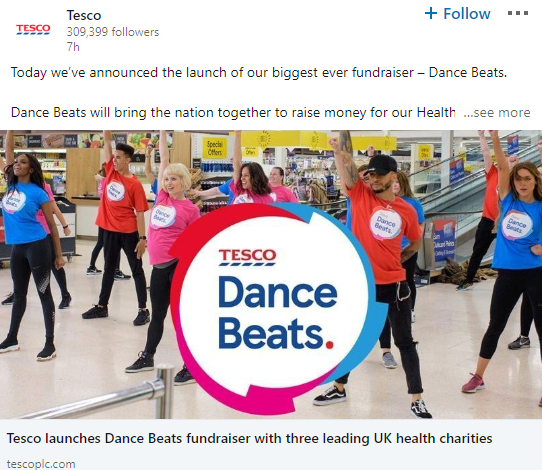Harnessing Social Media for Recruitment
By Laurie Wood

Social media has developed and evolved in such a way that it has now become an incredibly beneficial tool for recruiters/employers and job seekers. Outside of day-to-day personal use, social media can offer the platform to boost a job seeker’s professional online presence, help recruiters/employers find the right talent with the right fit and generally aid the recruitment process. The general term for this is social recruiting and below I’m going to discuss the benefits and some best practices.
JOB SEEKERS
When seeking a job, most people’s first course of action is to use a consulting agency or search online, primarily using job boards like Indeed or Jobsite. But, you don’t want to put all your eggs in one basket, by broadening your job hunt to include social media, you’re opening yourself up to many more career possibilities. A whopping 79% of you use social media in your job search already and within that 79%, 14% of you have actually landed the job which you applied for via social media. Let’s have a look at how we can increase that 14% with a few tips.
- TIDY UP YOUR ONLINE PRESENCE
Before surfing social sites getting ready to apply, you need to clean up your online presence. Yes, i’m talking about hiding those drunken photos of a party you attended! 70% of employers screen candidates social media profiles during the application phase and 54% choose not to hire candidates based on what they’ve seen. Now, everyone is entitled to their personal life, but, employers have reputations to uphold and a standard set for their company which is important for their business relationships. The simple solution here is to change your privacy settings from public to friends-only. This means you can still apply for that position without any fear your social presence will have a negative impact on your chances. Once you’ve tidied up your online presence, now would be a good time to update any important information such as links to websites, contact numbers or anything else which might make you appear more desirable to the recruiter/employer.
Another tip, head over to LinkedIn and ensure your work history is on point, with all relevant information updated and add any Skill keywords which are listed under the job vacancy’s Essential or Desirable specifications (obviously, providing you are skilled in the area). You can read more about nurturing your LinkedIn profile in one of my other blogs, here.
2 - KNOW WHERE TO LOOK
Let’s start with LinkedIn – Because of LinkedIn’s reputation of being a business-focused social network, recruiters/employers expect to find the right talent and the right people who are taking their careers seriously. As a result, filling out your LinkedIn profile to the best of your ability and flaunting your expertise and skills increases your chance of being noticed by recruiters/employers – not only does it promote your strengths but, it makes you appear pro-active. LinkedIn has a really easy to use job search function, although you can only use it if you have a LinkedIn profile, but, why wouldn’t you?
2
Moving on, Facebook and Instagram – Don’t underestimate these platforms, although they are not as “job seeker-friendly”, recruiters/employers regularly use these platforms to promote opportunities through sponsored posts (you’ll see these sporadically on your feed) and organic posting (will be posted from a company on their timeline). Although you can’t control what and when to see a sponsored post on your timeline, you can follow a company’s social media presence and be in the first to know if they share an organic job. Also note, that some companies will have a separate Facebook page dedicated to sharing opportunities and nurturing new employees.
2
Facebook and Instagram both have a search function which you can spend time discovering opportunities, although it’s not as easy to use as LinkedIn. On Facebook, you can search for phrases or job titles like Now Hiring and Sales Assistant and filter the location to the area you want. You can also use Facebook groups. As we know, Mark Zuckerberg bloody loves Facebook groups as it’s a way to feel closer to family and friends, but, how can job seekers use groups? Other than feeling closer to others, groups can be used as funnels to connect like-minded individuals. Search for “Jobs in [location]”, these are very popular and you can feel at ease knowing this group will only post jobs based in that specific location. You can also post yourself in these groups, essentially advertising what you’re looking for in a job and what skills you have to offer.
–

Instagram doesn’t have a multiple search function like Facebook. You can search for hashtags like #NowHiring or #SalesAssistant but your results will be incredibly broad. To help narrow this down, research branded company hashtags instead. Starbucks utilises the hashtag #ToBeABarrister – both employees and Starbucks uses this to promote life as a barrister and potential job opportunities.
–
Finally, you can also use this search function technique on Twitter. They offer similar search functions to Facebook in terms of narrowing down your search with keywords and setting the location to “near you”.
–2 - CONNECT AND NETWORK WITH OPPORTUNITIES
You’ve just applied for a fantastic job and want to really stand out from the crowd as someone who is eager and more than qualified for the role. How can you get noticed? You could call up the employer and check to see they received your application… Bleh, Yawn! Or, you could socially engage and connect with the employer and company by following their social presence and like & comment on their posts. This will highlight to the recruiter and employer your interest and also give them a nudge to go check out your credentials.
RECRUITERS AND EMPLOYERS
Social recruiting is a form of e-recruitment and it’s a strategy used by a staggering 94% of recruiters/employers and with good reason too. Social media is so integrated within our lives the average UK based user spends 1 hour 50 minutes per day scrolling through social media sites. If you’re hiring and haven’t thought about utilising social recruiting then what are you waiting for? Below, i’m going to list how you can leverage social media for your recruitment needs.
- SHOWCASING WHAT YOUR COMPANY HAS TO OFFER
Social media can work as an extension of your business by working as a free mini-site, used to enhance your company’s marketing strategy, increase conversions and nurture customer relationships. 94% of customers expect a business to have some form of social media presence so it’s important that not only do you fulfill that expectation, you exceed it by offering a mind-blowing marketing strategy. Generally speaking, all platforms can be leveraged to showcase company success, insight to specific job roles and benefits, but, each platform tends to work best when its focus is around a certain aspect.
2
I like to think of Facebook as the umbrella pole to content – content from day in the lifeof videos, articles regarding company awards or company blogs all tend to work well. It’s more about focussing on keeping content mediums varied. Arguably, Twitter can follow the same content format as Facebook, however, unlike Facebook, Twitter’s fast-paced environment means it’s the perfect platform to tweet any live-events and keep your followers regularly updated.
2
As Instagram is an image-based platform, many companies like HubSpot, TripAdvisor, and Adobe find embracing their company culture and flaunting life inside their business the best approach. Think of Instagram as your business’ photo album, what would you like to see when you open those pages? Anything from office parties, to charity events and birthdays, is all encouraged to be shared on this platform. Use it as a tool to remind potential new employees that your company is run by humans, not corporate robots, and although you work hard, you play hard too.
–
–
Finally, we move onto LinkedIn, the professional network. Content shared on LinkedIn should be focused around company and business news and updates. But, this also means you can share company awards, employee recognitions and taking part in charity events – use LinkedIn to highlight how well your business is doing and what impact it’s having on others, as this will support a candidates decision when applying for a role. Candidates need to have confidence in the company as much as the role description itself.
– –
– - IN-DEPTH TARGETING
Worried using social media to recruit could lead to a large pool of watered-down talent? Fear not! With the goal and campaign set-up, social media can specifically target candidates in your desired location and with the right skill-set.
Starting with Facebook and Instagram which have arguably the most in-depth targeting features, you can select from job titles, education, interests, age, gender and much more. What makes these platforms stand-out from of the rest is they offer a large catalog of options to choose from and you can narrow down even further by ensuring your potential candidate pool has more than one option listed on their profiles. This precise targeting allows you to hone in on the most skilled or experienced candidates while making your budget spends more accurate.
Twitter focuses primarily on targeting those who match specific keywords and/or who follow particular accounts. But, you can also target conversation topics and generic interests. Twitter campaigns can gain a lot of impressions, meaning it is the perfect platform to promote a recruitment event.
–
LinkedIn, allows you to target location and Skill keywords, meaning the advertisement will only appear on the newsfeeds of those who match the location and/or skill – So be certain you have selected the best Skill keywords for your vacancy.Finally, Snapchat which is still in BETA in the UK lets you target peoples lifestyles. Although this is the broadest of the platforms targeting options, it’s very popular among young audiences and the desired platforms to promote any apprenticeships or internships as the talent pool will largely have little to no work experience.
– - SCREEN CANDIDATES
Screening social media profiles have always been a bit of a hot topic with 61.8% of recruiters/employers willing to screen a candidates profile but, 62.7% of job seekers saying it shouldn’t be part of the recruitment process. The advantage of screening a candidate’s social media presence gives you an insight into who that candidate really is and this can help decide whether or not they would be a good culture fit for your company. The candidate may have a strong social presence with relevant skills and work examples shown on LinkedIn. But, use judgment and watch out for red flags such as any references to illegal drugs, discriminatory comments and notable spelling errors may reflect the candidate’s communication and writing skills and finally, if there is any inconsistency with profile images this could affect legibility – is this person really who they say they are?
– - REACH PASSIVE CANDIDATES
For a moment, think of yourself as a big Harry Potter fan, you’re scrolling down your timeline and you see a Sponsored Ad for a book signing from JK herself. You haven’t seen this advertised anywhere else, but you click to find out more. You were not actively looking for a book signing, but the advert appeared anyway as the advertiser targeted you, a Harry Potter fan, to show this to. This is the power of social advertisement and in recruitment terms reaching passive candidates. Social media is a talent pool of skilled candidates, some with the perfect skills for the job you would like to advertise for, but, just like the Harry Potter fan, they’re not actively looking. Perhaps they’re settled in their job, maybe they are not aware that something better is out there or not looking for personal reasons, either way, social advertisement means you can alert those passive candidates on an opportunity they may have never even seen before and expand your reach to hopefully find the best candidate for the role.
– - COST-EFFECTIVE
In comparison to more traditional means of recruiting, using social media to recruit is incredibly cost-effective which is obviously valuable if you’re on a budget. Outside of using standard Sponsored Posts to promote your vacancy, social media has the power to offer unlimited reach through targeting and online word-of-mouth through various forms of content engagement. How much does it cost? Well, that depends on how much you want to invest in it. Traditional forms of advertising such as radio advertisement can cost around £200 for a 30-second advert. You’re restricted on medium and less able to hype up your advert using social media tools like follow-up posts and hashtags.
Whereas you can promote on Twitter and Google Ads from £1 per day, Facebook & Instagram from £5 per day, LinkedIn from £7.85 per day and Snapchat £50 per day. With the most optimized targeting and extra build-up of hype on your social media presence, you can make a few pounds go a really long way.
–
Want to know more about utilising social media? Follow me @LaurieWoodUk.
The kind of stuff that Social Hire do...
We won't just do social media strategies. Social Hire will work collaboratively with your team to ensure your business gets genuine value from us and that your team gets the most out of the service. Our experienced social media managers are motivated to make a enhancements to your social media marketing and reaching targets in a way that realistically makes a difference to your business goals.
Our digital marketing managers are the wizards that can give you the insight you need to grow your business. Have you had enough of making difficult personnel choices that don't work well for your online marketing?
Our group of specialists are an organisation that helps our clients boost their online marketing by offering social media management services on a monthly basis.
You might like these blog posts How Can Social Media Benefit You and Your Employees?, Apprenticeship Programs: A Solution to the Skills Problem?, 8 Social Media Tips for Ecommerce Businesses, and All Together Now: How To Create A Strong Management Team.
